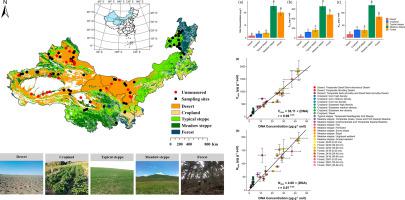Applied Soil Ecology ( IF 4.8 ) Pub Date : 2020-12-25 , DOI: 10.1016/j.apsoil.2020.103869 Haiyang Gong , Qiajun Du , Shubin Xie , Weigang Hu , Muhammad Adnan Akram , Qingqing Hou , Longwei Dong , Ying Sun , Abdul Manan , Yan Deng , Jinzhi Ran , Jianming Deng

|
Soil microbes exert critical control over ecosystem functions by regulating organic matter decomposition and nutrient cycling. Diverse methods have been adopted to estimate the soil microbial biomass carbon (Cmic) and nitrogen (Nmic), largely based on fumigation and respiration or biomarkers, such as phospholipids and ATP. Although soil microbial DNA is also an important biomarker, whether this biomarker can be used to estimate Cmic and Nmic at a large scale in arid and semi-arid regions that remains unclear. To explore this, the 124 soil samples collected from 28 different vegetation/microhabitat types in diverse ecosystems (i.e., desert, cropland, typical steppe, meadow steppe and forest) across arid and semi-arid regions in northern China; then, the strong linear relationships were developed among soil microbial DNA concentrations with the Cmic and Nmic contents estimated by the classic chloroform fumigation-extraction (CFE) method. The results showed that the soil microbial DNA concentrations were linearly related to the observed Cmic (r = 0.99) and Nmic (r = 0.97) across the diverse vegetation types, although soil microbial biomass presented an enormous fluctuation. Moreover, based on the above-mentioned coefficients of the linear relationship, it was further inferred that the mean proportions of carbon and nitrogen elements in DNA were 0.99% and 3.70% for Cmic and Nmic, respectively, when assuming the G-C base-pair proportion is 50% in double-stranded DNA. In conclusion, the study proved that soil microbial DNA as a powerful indicator may provide convenient and efficient estimates for Cmic and Nmic in arid and semi-arid systems. Although this method still needs to be further improved and examined at a larger scale, it provides a good addition to the already existing methods to determine microbial biomass.



























 京公网安备 11010802027423号
京公网安备 11010802027423号